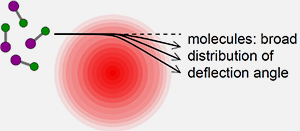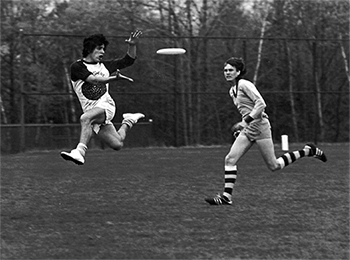Controlling the translational motion of atoms and molecules has been an important topic in physics for many years. Since the pioneering work of Stern and Gerlach, who deflected atoms along a magnetic field gradient, many other researchers have demonstrated atomic or molecular deflection, including deflection by electric field gradient and even by focused laser beams.
The advantage of deflection by field gradients is that it works on neutral atoms and molecules. An electric field – of, e.g., a laser – polarizes the atom or molecule and then deflects it via the interaction with the induced dipole.

But the story just begins here. Molecules, unlike atoms, have an anisotropic shape, and their interaction with external fields depends on the orientation of the molecule with respect to the field and its gradient. In a thermal ensemble, each molecule has a random orientation. The result is a broad distribution of the deflection angles.

In our theoretical work, we study how the broad distribution of the deflection angle can be manipulated by using additional laser pulses. For example, already a single laser pulse that aligns the molecules before they fly through the deflecting field drastically narrows the distribution of the deflection angle.
Even more, control is achieved when the molecules are excited to fast spinning in a selected plane prior to the deflection, e.g. by using the molecular propeller method or the optical centrifuge. Like a Frisbee, a player who tilts the angle of their toy in order to direct it to the desired location, tilting the rotation plane of the molecules allows one to control the direction the molecule is deflected to.

- E. Gershnabel and I. Sh. Averbukh, “Deflection of Field-Free Aligned Molecules”,
Phys. Rev. Lett. 104, 153001 (2010) - E. Gershnabel and I. Sh. Averbukh, “Controlling molecular scattering by laser-induced field-free alignment”, Phys. Rev. A 82, 033401 (2010)
- E. Gershnabel and I. Sh. Averbukh, “Electric deflection of rotating molecules”,
J. Chem. Phys. 134, 054304 (2011) - E. Gershnabel and I. Sh. Averbukh, “Deflection of rotating symmetric top molecules by inhomogeneous fields”, J. Chem. Phys. 135, 084307 (2011)
- E. Gershnabel, M. Shapiro, and I. Sh. Averbukh, “Stern-Gerlach deflection of field-free aligned paramagnetic molecules”, J. Chem. Phys. 135, 194310 (2011)
- J. Floß, E. Gershnabel, and I. Sh. Averbukh, “Motion of spinning molecules in inhomogeneous fields”, Phys. Rev. A 83, 025401 (2011)


